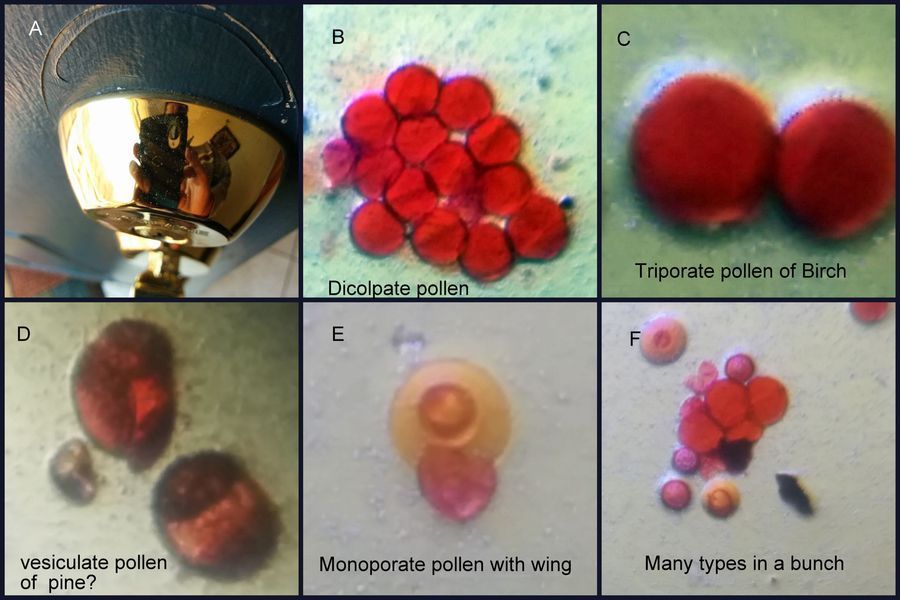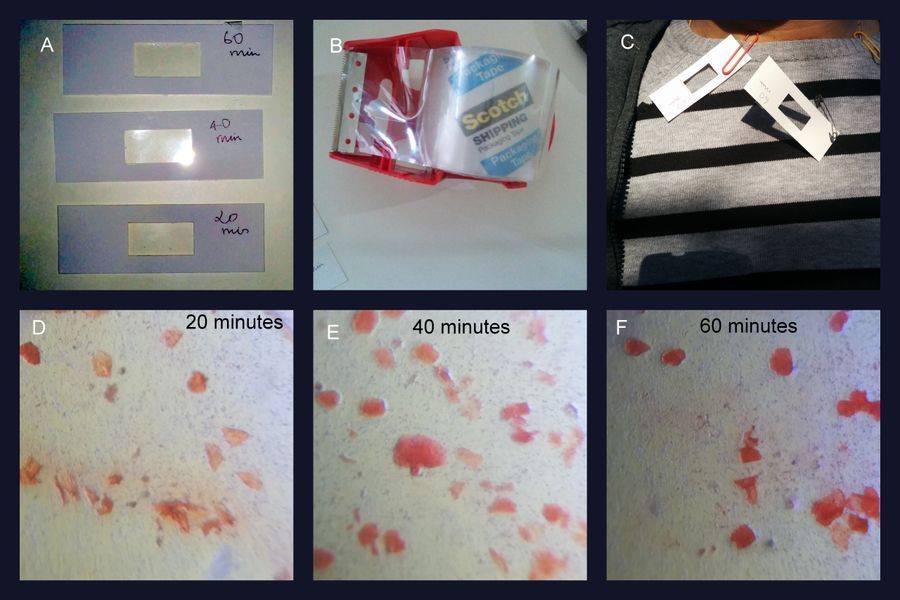Monitoring microscopic air-borne allergens using Foldscope
 Apr 05, 2015 • 9:46 PM UTC
Apr 05, 2015 • 9:46 PM UTC Unknown Location
Unknown Location 140x Magnification
140x Magnification Microorganisms
Microorganisms
laksiyer
Human observer of life. https://sukshmadarshin.wordpress.com
97posts
1255comments
5locations

Come Spring in the north-east of USA and life springs back on board. The fury with which which leaves, trees, ponds, insects, birds break out everywhere is a joy to behold. Poems about the cuckoo heralding spring (Thrice welcome, darling of the Spring!… by Wordsworth), come flooding to mind. For me however, the heralding of Spring begins with a sneeze at home accompanied with watery eyes, runny noses, high tempers and no sleep. I just watch helplessly as this member of my family breaks down for about 3 weeks. Spring allergies are an immune reaction to pollen proteins, people differ in their pollen sensitivities. There is this nice website pollen.com that gives us the pollen forecast for the day. They use an index to measure the pollen count. However, each local area is different and I often wondered if there was an easier way to understand and more importantly see these triggers.
Ever since the foldscope arrived, I have been thinking about this series of experiments for monitoring air-borne allergens using the foldscope. However, to be of any serious use one needs to understand its feasibility and limitations. First what do they look like? On the first warm day of Spring, I looked at my door lock (Figure 1A) and found a dust layer of what I thought was pollen. I took a cellophane tape and stuck it to the lock and ripped off whatever stuck to it. I then put the sticky end face down on a slide with a very dilute solution of Safranin O (1 drop of Safranin O in 19 drops of water). The pollen stained satisfactorily (Figure 1B-F). I could detect at least 4 different types (and perhaps a fifth one). My best guesses for at least two of the pollen sources are in Figure 1. However, I need to find a good key for the rest and need to develop an eye for them. These shapes are truly amazing and I can see how palynologists can spend a life time studying them. The major pollen types listed by pollen.com around the days of my sampling were maple, birch, elm, poplar and willow, of which I only saw the birch type. I didnt see the other types of pollen on my door knob, which means that either my local area profile is different or that these might have accumulated on my lock over some time.
Ever since the foldscope arrived, I have been thinking about this series of experiments for monitoring air-borne allergens using the foldscope. However, to be of any serious use one needs to understand its feasibility and limitations. First what do they look like? On the first warm day of Spring, I looked at my door lock (Figure 1A) and found a dust layer of what I thought was pollen. I took a cellophane tape and stuck it to the lock and ripped off whatever stuck to it. I then put the sticky end face down on a slide with a very dilute solution of Safranin O (1 drop of Safranin O in 19 drops of water). The pollen stained satisfactorily (Figure 1B-F). I could detect at least 4 different types (and perhaps a fifth one). My best guesses for at least two of the pollen sources are in Figure 1. However, I need to find a good key for the rest and need to develop an eye for them. These shapes are truly amazing and I can see how palynologists can spend a life time studying them. The major pollen types listed by pollen.com around the days of my sampling were maple, birch, elm, poplar and willow, of which I only saw the birch type. I didnt see the other types of pollen on my door knob, which means that either my local area profile is different or that these might have accumulated on my lock over some time.

Figure 1
The next challenge was to monitor the pollen in the air. For this I stuck cellophane tape across the foldscope paper slide and pinned it to my shirt. I exposed the paper slides for 20, 40 and 60 minutes during my morning walk. Although many things were stuck, they did not resemble pollen grains (Figure 2D-F). There were some interesting shapes though I cant believe that we are constantly being bombarded by something other than molecules of air :). BTW, for some time I was convincing myself that these are pollen until the expert brought me down to reality (Talk about delusions).
The next challenge was to monitor the pollen in the air. For this I stuck cellophane tape across the foldscope paper slide and pinned it to my shirt. I exposed the paper slides for 20, 40 and 60 minutes during my morning walk. Although many things were stuck, they did not resemble pollen grains (Figure 2D-F). There were some interesting shapes though I cant believe that we are constantly being bombarded by something other than molecules of air :). BTW, for some time I was convincing myself that these are pollen until the expert brought me down to reality (Talk about delusions).

Figure 2
This meant that one might require more exposure and I tied a paper slide with tape in my balcony/deck overnight. This time I did find a few pollen, but they were still just about one per field, and there was a lot of the other stuff (see Figure 3H below).
This meant that one might require more exposure and I tied a paper slide with tape in my balcony/deck overnight. This time I did find a few pollen, but they were still just about one per field, and there was a lot of the other stuff (see Figure 3H below).

Figure 3
I realize that this is going to be a long haul and I need to categorize all the pollen shapes with the flowers, pollen.com, the allergic responses and the efficacy of my monitors. This far the first sniffles of the allergic response have begun. I plan to increase the exposure time, try other sticky substances and a few other ideas. I am not going to give up so easily yet. I hope some of you can join me to finding a means to design and standardize a personal allergen monitor using a foldscope. Looking forward to picking your minds.
I realize that this is going to be a long haul and I need to categorize all the pollen shapes with the flowers, pollen.com, the allergic responses and the efficacy of my monitors. This far the first sniffles of the allergic response have begun. I plan to increase the exposure time, try other sticky substances and a few other ideas. I am not going to give up so easily yet. I hope some of you can join me to finding a means to design and standardize a personal allergen monitor using a foldscope. Looking forward to picking your minds.
Sign in to commentNobody has commented yet... Share your thoughts with the author and start the discussion!

 0 Applause
0 Applause 0 Comments
0 Comments_300x300.jpeg)

















